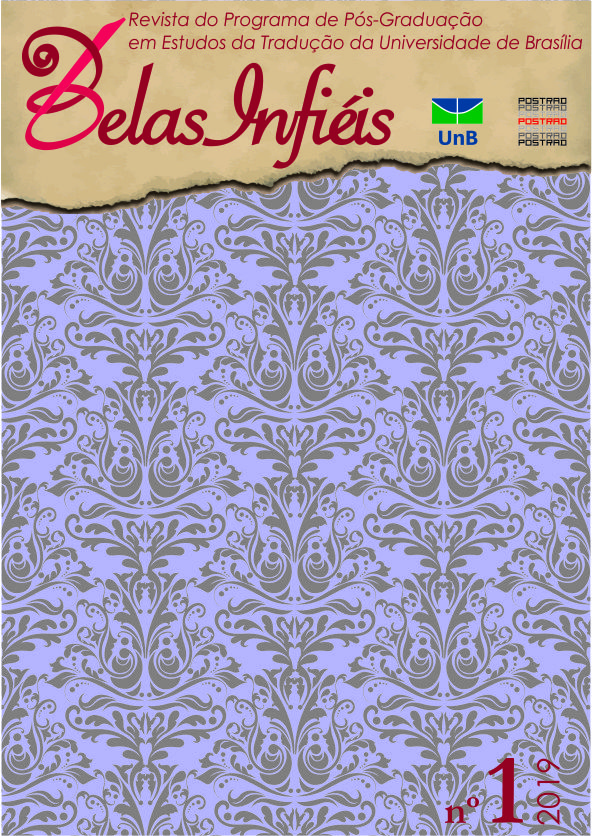The Translation of Sacred Texts to Sign Language
the Ten Commandments Permeated by Different Discursive Voices
DOI:
https://doi.org/10.26512/belasinfieis.v8.n1.2019.13012Keywords:
Sign Language, Sacred Texts, The Ten Commandments.Abstract
: This”‹ study aims at investigating the translation of sacred texts to the Brazilian Sign Language (Libras) in view of the utilization of these materials in the training of Sign Language translators and interpreters in and out of religious institutions. To that end, we rely on the theoretical contributions of Bakthin (1992, 2003), Sobral (2008), Gohn (2001), Jonnings (2003), among others in order to to know how the divine discourse is produced and the contextual elements which interfere in the production of these cultural objects. In the development of this study, a bibliographical-documental research was carried out, extracting, as the object of analysis, two videos translated to Sign Language by two distinct religious instituions based on the biblical text Exodus 20: 1-17, which talks about the "Ten Commandments". The results revealed that the work of translators and their translation choices are directly influenced by the religious institutions and their discourses, by the control devices and the social locations/positions which these subjects occupy inside these institutions.
Downloads
References
ASSIS SILVA, C. A. Cultura surda: agentes religiosos e a construção de uma identidade. São Paulo: Terceiro Nome, 2011.
BAKHTIN, M. M. Os gêneros do discurso. IN: Estética da criação verbal. 4. ed. São Paulo: Martins Fontes, 2003.
BAKHTIN, M. M. (VOLOCHINOV. V. N.) Marxismo e filosofia da linguagem: problemas fundamentais do método sociológico na ciência da linguagem. 11 ed. São Paulo: Hucitec, 1992.
BARBOSA, Heloisa Gonçalves. Procedimentos técnicos da tradução: uma nova proposta. Campinas: Editora Pontes, 2004.
FILHO, J. C.; COIMBRA, D. P. Um estudo exegético em êxodo 20.1-6. Monografia, 2009. Faculdade de Educação Teológica da Amazônia. Disponível em <http://www.metodistavilaisabel.org.br/docs/UM-ESTUDO-EXEG%C3%89TICO-EM-EXODO-20.pdf>. Acesso em: 01 mar. 2018.
GOHN, C. Pesquisas em torno de textos sensíveis: os livros sagrados. IN: PAGANO, A. S. (Org.). Metodologias de pesquisa em tradução. Belo Horizonte: Faculdade de Letras, UFMG, 2001. p. 147-170.
KEELEY, R. Fundamentos da Teologia Cristã. Traduzido por: Yolanda Krievin. São Paulo: Vida, 2000.
KONINGS, J. Tradução e traduções da Bíblia no Brasil. Revista Perspectiva Teológica, v.35, 2003, pp. 215 - 238. Disponível em: <http://www.faje.edu.br/periodicos/index.php/perspectiva/article/viewFile/574/998>. Acesso em 01 mar. 2018.
NAPOLITANO, M. “Fontes audiovisuais: a história depois do papel” IN: PINSKY, Carla (Org). Fontes históricas. São Paulo, Contexto, 2010.
NEVES, M.H.M; LOPES, M.M.M. Texto Bíblico e “tradução”: a “voz divina” no plano humano da coenunciação. Cadernos de Tradução [online]. 2016, v. 36, n.2 p. 205-236. Disponível em: < http://dx.doi.org/10.5007/2175-7968.2016v36n2p205> Acesso em: 01 mar. 2018.
SELLIN, E.; FOHRER, G. Introdução ao Antigo Testamento: livros históricos e códigos legais. Traduzido por: D. Mateus Rocha. São Paulo: Paulinas, 1977, vol. 1.
SOBRAL, A. Dizer o 'mesmo' a outros: ensaios sobre tradução. São Paulo: SBS-Special Book Services, 2008.
Downloads
Published
How to Cite
Issue
Section
License
Given the public access to this journal, the texts are free to use but requires the recognition of the original authorship and initial publication in this journal to be properly stated.
 The journal allows the use of works published for non-commercial purposes, including the right to submit the work to publicly accessible databases. Published contributions are the sole and exclusive responsibility of the author(s).Â



















